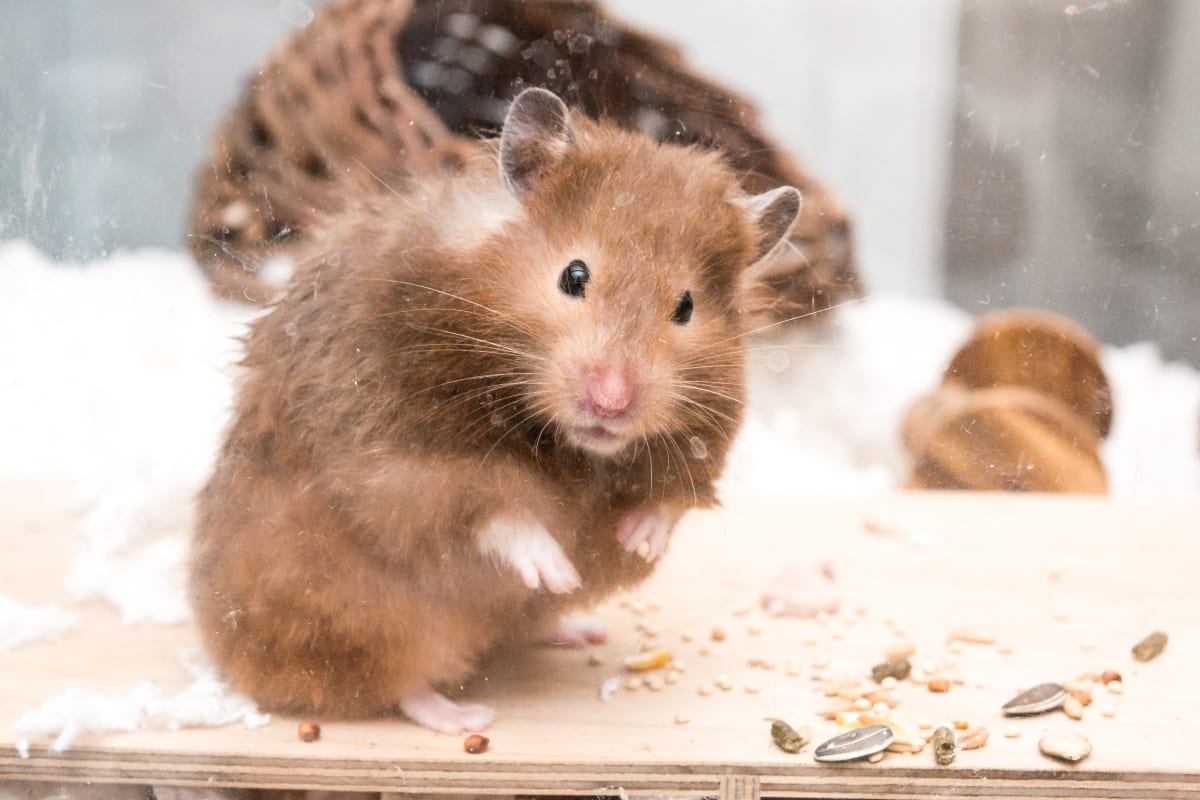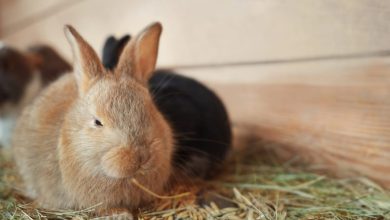How Big Should a Hamster Cage Be? What the Research Says

Hamsters might be petite animals, but they still need plenty of room in their cage to forage, burrow, run, and explore. Our pet’s wild cousins run up to 6 miles a day, going back and forth while foraging and bringing the food they find to their underground chambers. It’s important to allow our pets to express their natural instincts and provide enough stimulation by choosing a spacious cage.
While keeping hamsters in small cages that lack enrichment is still very common, the word is slowly getting out there, and more and more people are choosing larger enclosures.
If you’re wondering how big of a cage your hamster needs, we bring you an overview of minimum cage size standards by different animal welfare organizations and the standards we follow ourselves.
Minimum Hamster Cage Size Standards
How big should a hamster cage be, exactly? That depends greatly on who you ask.
Most pet stores are only interested in filling their cash registers with money; animals’ well-being is secondary at best. Selling small cages also makes hamster keeping more accessible to potential pet owners who want a cheap pet that doesn’t take much room. This benefits pet stores by increasing the “pool” of potential customers.
On the other hand, animal welfare organizations and charities try to improve the standards and work on pushing laws that benefit our pets. While there are many different opinions on how big a hamster cage should be, all animal welfare organizations agree on one thing – the bigger, the better!
Let’s look at what animal welfare organizations worldwide recommend as the minimum hamster cage size.
Blue Cross
Blue Cross is a registered animal welfare charity founded in the United Kingdom. They note that the ideal cage should have no less than 100cm x 50cm of floor space and be 50cm tall for both Syrian and dwarf hamsters.
Syrian & dwarf hamsters
- Minimum Floor Space: 775 sq. in. or 5000 cm²
- Minimum Cage Dimensions (LxWxH): 100 cm x 50 cm x 50 cm
Woodgreen
Woodgreen is an animal charity and shelter founded way back in 1924 in the UK. They are a multi-species charity, caring for a broad range of pets needing help, including hamsters.
Syrian hamsters
- Minimum Floor Space: 620 sq. in. or 4000 cm²
- Minimum Cage Dimensions (LxWxH): 80 cm x 50 cm x 50 cm
Dwarf hamsters
- Minimum Floor Space: 620 sq. in. or 4000 cm²
- Minimum Cage Dimensions (LxWxH): 80 cm x 50 cm x 35 cm
TVT
The Veterinary Association for Animal Welfare (TVT) is a non-profit association based in Frankfurt, Germany, founded by 150 veterinarians committed to improving animal welfare.
Germany has some of the best standards for hamster care in the world, and they are the ones that first introduced 775 sq. in. as the appropriate cage size. According to them, 100 x 50 cm is the absolute minimum cage size for keeping pet hamsters of all species.
Syrian & dwarf hamsters
- Minimum Floor Space: 775 sq. in. or 5000 cm²
- Minimum Cage Dimensions: 100 cm x 50 cm x 50 cm
PDSA
PDSA (The People’s Dispensary for Sick Animals) is a veterinary charity founded in 1917 in the United Kingdom. Their recommendations follow those of the TVT.
Syrian & dwarf hamsters
- Minimum Floor Space: 775 sq. in. or 5000 cm²
- Minimum Cage Dimensions: 100 cm x 50 cm x 50 cm
German Ministry of Food and Agriculture
The German Ministry of food and agriculture advises the following cage minimum:
Syrian hamsters
- Minimum Floor Space: 775 sq. in. or 5000 cm²
Dwarf hamsters
- Minimum Floor Space: 465 sq. in. or 3000 cm²
In 2014, a law was enacted that requires German pet shops to inform customers of the minimum cage size requirements. That’s probably one of the reasons large hamster cages are so popular in Germany, and you won’t see many tiny cages on their local hamster forums.
While the minimum cage size for dwarfs is much smaller than for Syrians, most experienced hamster owners in Germany follow the minimum size of 775 sq. in. for all hamster species.
California Hamster Association
California Hamster Association is a club of hamster breeders and owners working to improve how hamsters are treated. According to them, an appropriate hamster cage meets or exceeds 600 square inches for all hamsters.
Syrian & dwarf hamsters
- Minimum Floor Space: 600 sq. in. or 3870 cm²
RSPCA
Royal Society for the Prevention of Cruelty to Animals (RSPCA) used to have cage size requirements but has since stopped recommending the minimum due to a lack of evidence on what hamsters prefer. Now, they suggest hamster owners “buy as large a cage as they can.”
Previously, they’ve used the following size requirements:
Syrian hamsters
- Minimum Floor Space: 620 sq. in. or 4000 cm²
- Minimum Cage Dimensions: 80 cm x 50 cm
Dwarf hamsters
- Minimum Floor Space: 430 sq. in. or 2774 cm²
- Minimum Cage Dimensions: 70 cm x 40 cm
Many hamster owners and animal welfare organizations still follow RSPCA’s previous guidelines.
Hamster Society Singapore
Hamster Society Singapore is a non-profit group of volunteers and animal lovers who assist, rescue, foster, and rehabilitate hamsters. The minimum requirements that they also expect from their adopters are 90x50x50cm.
Syrian & dwarf hamsters
- Minimum Floor Space: 698 sq. in. or 4500 cm²
- Minimum Cage Dimensions: 90 cm x 50 cm x 50 cm
Hamsters South Africa
Hamsters South Africa is a go-to hamster care website for people in South Africa. It provides hamster owners with advice and tips based on the latest research. According to them, an absolute minimum unbroken floor space should be 5000 cm2 (for example, 100 cm x 50 cm) for both Syrian and dwarf hamsters.
Syrian & dwarf hamsters
- Minimum Floor Space: 775 sq. in. or 5000 cm²
Why Do Hamsters Need This Much Space?

These requirements might seem like a lot, but considering how active hamsters are in the wild and how big their natural territories are, the recommended cage sizes are actually just a tiny glimpse of that.
Although hamsters in captivity will never have a space nearly as big as they would in the wild, it’s important to provide a cage that allows them to express their instincts which is essential for their well-being.
Let’s see what the research says about hamster cage size.
Effects of Cage Size on Hamster’s Welfare
A study from 2007 investigated the behavior of golden hamsters kept in four cage sizes:
- 1,800 cm² (280 sq. in.)
- 2,500 cm² (387 sq. in.)
- 5,000 cm² (775 sq. in.)
- and 10,000 cm² (1550 sq. in.)
Everything other than the cage size was the same, and they all had a 30-cm running wheel. Researchers used different hamster behaviors, such as stereotypic wire-gnawing and weight gain, as welfare indicators to figure out how cage size affects hamsters’ stress levels.
While stereotypic wire-gnawing was seen in cages of all sizes, it was significantly more frequent and longer in smaller cages. Based on that research, we can say that Syrian hamsters benefit from a cage with a larger floor space, and 10,000 cm² would be an even better size for them than smaller cages.
Effect of Cage Size & Enrichment on Hamster’s Febrile Response
Two other studies looked at how the size of a cage and the presence of enrichment in the cage affects the thermoregulation (regulation of body temperature) of golden hamsters.
The study found that the rectal temperature of hamsters in small cages was higher than those in large cages. By increasing the size of the cage and adding enrichment, the febrile response increased while the baseline rectal temperature decreased. This suggests that housing hamsters in small cages can cause chronic stress, which negatively affects thermoregulation. [source] [source]
What Size We Aim For
Having various guidelines from different sources can be pretty overwhelming and confusing. How to decide which one to follow?
Overwhelming evidence from the studies above shows hamsters prefer and do better in larger cages. Additionally, larger cages can fit many more enrichment items and allow hamsters more space to explore and express their natural behaviors.
I highly recommend getting a cage that equals or exceeds 775 sq. in. or 5000 cm² which is set to be a bare minimum by The Veterinary Association for Animal Welfare in Germany and many other animal welfare organizations.
Aim for the biggest you can find and afford while not jeopardizing other important aspects of the cage in the process – such as proper ventilation, bedding depth, wheel size, etc.
What to do if you can’t afford a large cage?
If you already have a small cage for your hamster and would love to switch to a cage that meets the minimum – if only you had the cash – there are some available options:
- Cheap second-hand aquariums (see aquarium sizes below) from Facebook marketplace, Craigslist, etc.
- Second-hand IKEA Detolf would make a very spacious hamster cage. A brand new IKEA Detolf cabinet is not too expensive either.
- Large plastic storage bins can be transformed into a hamster cage, but you’ll need to create a mesh lid for ventilation, as explained in this video.
| Tank size | LxWxH | Floor space (sq. in.) | Is it suitable? |
|---|---|---|---|
| 30 gallon (breeder) | 36″ x 18″ x 12″ | 648 sq. in. | No |
| 40 gallon (breeder) | 36″ x 18″ x 16″ | 648 sq. in. | No |
| 40 gallon (long) | 48″ x 12″ x 16″ | 576 sq. in. | No |
| 50 gallon | 36″ x 18″ x 19″ | 648 sq. in. | No |
| 55 gallon | 48″ x 13″ x 21″ | 624 sq. in. | No |
| 65 gallon | 36″ x 18″ x 24″ | 648 sq. in. | No |
| 75 gallon | 48″ x 18″ x 21″ | 864 sq. in. | Yes |
| 90 gallon | 48″ x 18″ x 24″ | 864 sq. in. | Yes |
| 125 gallon | 72″ x 18″ x 21″ | 1296 sq. in. | Yes |
| 150 gallon | 72″ x 18″ x 28″ | 1296 sq. in. | Yes |
| 180 gallon | 72″ x 24″ x 25″ | 1728 sq. in. | Yes |
Our favorite currently is the IKEA Detolf which provides 1074 square inches of floor space and is much cheaper than many smaller hamster cages in pet shops. Although, you’d need to make a DIY lid to be able to use it.
You can see other suitable hamster cages here. If you’re not sure your current cage is large enough, use this hamster cage calculator to check.
What Else is Important Other Than Cage Size?

While cage size is of utmost importance, it’s not the sole factor in a hamster’s happiness. One thing that affects hamsters just as much as cage size is cage enrichment. A large cage that lacks enrichment items such as a running wheel, deep bedding, a sand bath, and hideouts is just as bad for hamsters as a small cage.
Deep Bedding
A study by the University of Berne investigated how different bedding depths and stressors affected the behavior and well-being of golden hamsters. They housed 45 male golden hamsters in cages with different depths of bedding (80 cm, 40 cm, or 10 cm) and monitored their behavior, including how much they used their running wheel and how much they gnawed on the wire of their cage.
The results showed that the hamsters in the group with the least bedding (10 cm) had more wire-gnawing and more running wheel activity than the other groups, and the hamsters in the group with the most bedding (80 cm) were the most active in digging and constructing burrows which they occupied.
The study indicates that providing golden hamsters with at least 40 cm of bedding can improve their welfare and lower their stress levels.
Hamsters in the wild create burrows that range 36 – 106 cm in depth with multiple chambers for different purposes, such as nesting and stashing food. While we can’t provide them with that much bedding in our humble homes, we can still work within our possibilities to give them a deep substrate to dig and create burrows.
That’s why it’s important to buy a cage large enough to fit a deep layer of bedding that allows your hamster to dig and burrow. Here are the recommended standards for bedding depth:
- Minimum 6 inches of bedding, preferably 10 inches – for dwarf species and Chinese hamsters
- Minimum 10 inches, preferably 12 inches or more – for Syrian hamsters
Enrichment
Other than bedding, it’s important to provide different textures such as a sand bath and additional digging areas, chewables, foraging plants, cage accessories such as hideouts, platforms, bridges, tunnels, and, of course, a running wheel.
Read my hamster cage setup guide for more info on creating a fun and engaging hamster cage.
Conclusion
Hamster care standards have massively improved in recent years, from keeping pet hamsters exclusively in tiny cages to large hamster enclosures resembling their natural habitats getting increasingly popular.
By better understanding the needs of hamsters and how much space they need, we can work on improving our pets’ lives, demand better care from pet stores, and promote improved standards among new hamster owners.



